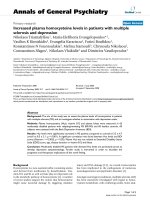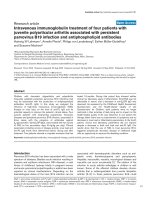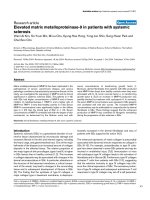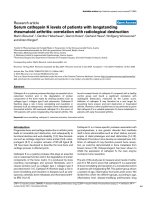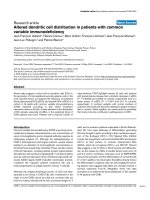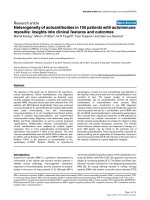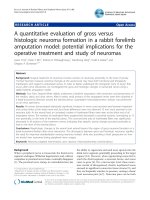Báo cáo y học: " A well-being support program for patients with severe mental illness: a service evaluation" docx
Bạn đang xem bản rút gọn của tài liệu. Xem và tải ngay bản đầy đủ của tài liệu tại đây (233.33 KB, 9 trang )
RESEARCH ARTICLE Open Access
A well-being support program for patients with
severe mental illness: a service evaluation
Donna Eldridge
1
, Nicky Dawber
1
, Richard Gray
2*
Abstract
Background: The risk of cardiovascular disease is increased in patients with severe mental illness (SMI) dramatically
reducing life expectancy.
Method: A real world pragmatic service evaluation of a Well-Being Support Program (WSP) was conducted. This
was a four-session package delivered over a one-year period by mental health practitioners that had received
additional training in providing physical health assessment and intervention. Patients’ physical health was screened
and appropriate one-to-one and group intervention was offered.
Results: 212 mental health practitioners were trained in the WSP and 782 patients were enrolled on the program.
The majority of our sample was overweight or obese; 66% had a Body Mass Index (BMI) >25. Lifestyle risk factors
for cardiovascular disease (CVD) were common and the patients had low self esteem. The average number of
formally recorded well-being sessions attended was 2.10. Just under a quarter of those patients enrolled in the
program completed. The only cardiovascular risk factor that significantly altered in patients that completed the
program was BMI. The qualitative feedback about the program was largely positive.
Conclusions: The need to intervene to enhance the physical health of people with SMI is beyond doubt.
Maintaining patient engagement in a physical health improvement program is challenging. Regular comprehensive
physical health monitoring is necessary to establish the benefit of intervention and increase life expectancy and
well-being in this population.
Background
Life expectancy for people with severe mental illness
(SMI), such as schizophrenia is reduced by at le ast 20%
compared with the general population [1,2]. The major
cause of death in this population is cardiovascular disease
(CVD) [3,4]. Just having a SMI may increase the risk of
CVD but this inherent vulnerability is compounded by
lifestyle factors that include a high fat and high calorie
diet, lack of exercise, smoking and substance use [5-7].
Weight gain and other side effects of antipsychotic medi-
cations used to treat SMI further add to the cardiovascu-
lar burden [8]. Recognizing and managing risk factors for
CVD and other physical co-morbidities is an important
unmet need in the S MI population [9]. Desp ite frequent
contact with primary care services, physica l health is
rarely monitored [10-12] an observation that may be
explained by diagnostic overshadowing (where presenting
symptoms are put down to the mental illness). SMI
patients are generally in regular contact with community
mental health workers who may be better placed to both
monitor and promote physical wellbeing [13]. There is
evidence that that mental health worke rs consider the
physical health of their patients an important part of
their role [14].
A Cochrane review [15] of physical health monitoring
for patients with SMI concl uded that there was no evi-
dence from RCTs to support current practice. Physical
health screening programs for SMI patients in secondar y
care have been described by Millar [16] and Shuel et al
[17]. In both, high rates of obesity and other CVD risk fac-
tors were observed and a high degree of patient apprecia-
tion for the programs was reported. Several exploratory
evaluations of physical health interventions designed or
adapted to b e delivered in secondary care have been
described [18-21]. For example, Ball et al [18] compared a
“Weight Watchers” program in 11 schizophrenia and 11
matched control patients but did not observe significant
* Correspondence:
2
Faculty of Health, University of East Anglia, Norwich, NR4 7TJ, UK
Full list of author information is available at the end of the article
Eldridge et al. BMC Psychiatry 2011, 11:46
/>© 2011 Eldridge et al; licensee BioMed Central Ltd. This is an Open Access article distributed under the terms o f the Cre ative Commons
Attribution License ( which permits unrestricted use, distribution, and reproduction in
any medium, provided the original work is properly cited.
weight loss as a result of the intervention. A service eva-
luation by Pendlebury et al [19] reported a mean reduction
in weight of just over 6 kg in a sample of 93 SMI patients
attending a mean of 42 beha vioral weight management
clinic sessions.
The Wellbeing Support Program (WSP) described by
Ohlsen et al [20] is perhaps the most important
described in the literature (because of the number of
serviceprovidersintheUKthathavegoneontoadopt
the program). The WSP is a nurse led screening service
that aimed to:
• Identify physical health problems,
• Promote treatment adherence,
• Encourage positive lifestyle change,
• Strengthen links between primary and secondary
care
• Provide support and advice to carers
• Direct pa tients to appropriate primary and second-
ary care services.
The service was facilitated by a team of nurse advisors
who provided Well-Being support as an adjunct to rou-
tine care. P rogram development, support for the nurse
advisors and subsequent evaluation was supported b y
the pharmaceutical company Eli-Lilly who manufacture
an antipsychotic medciation used to treat schizophrenia.
Delivered over a two year period the WSP is a five-
step program with a minimum of six face-to-face ses-
sions with a nurse wellbeing worker:
• Step 1: SMI patients are invited to participate and
enrolled on the WSP register
• Step 2: the first face-to-face well-being session
where physical health (blood pressure, pulse, weight
and height), lifestyle factors (diet, physical activity,
smoking status) are measured.
• Step 3: results (from session 1) are fed back to
patients at a second face-to-face session. Blood tests
(random blood glucose, thyroid function, liver func-
tion, serum prolactin, lipid screen) are performed
during this meeting
• Step 4: patients are referred by the practitioner to
one or more of the following: a weight management
or physical activity group, primary care or specialist
doctor for additional physical health care, or medica-
tion review by prescribing clinician
◦ Weight management groups are held weekly;
patients are weighed and there is an opportunit y
to access support information and advice.
◦ Physical activity groups were also held weekly.
Activities including, bowling, badminton, walking
and swimming were organized by the nurse.
• Step 5: follow-up face-to-face session(s) to evaluate
the program and complete follow-up measures (as in
step 1 and 2).
Patient progression through and adherence to the key
elements of the five stages of the program was carefully
monitored by the nurse advisors managers. Treatment
and training manuals and fidelity measures for the WSP
have not (to date) been published.
Smith et al. [21] addressed the question of whether the
Well-Being Support Program (WSP) provided in a second-
ary care setting was effective in modifying lifestyle factors
such as diet, lack of exercise and cigarette smoking. Out-
comes of the service were positive and encouraging. Of
the 966 patients enrolled, 80% completed the program,
and there were significant improvements in physical activ-
ity, smoking and diet [13,21]. It might be argued that
rather than advocating the rolling out the program
Well-Being Support should be subject to a randomized
controlled trial. Whilst there is considerable merit to this
argument many service providers were convinced that the
evidence from the service evaluation was sufficient to war-
rent adoption. Although we know anecdotally that many
secondary mental health services in the UK have adopted
the WSP actual numbers have not been published. As
Tosh et al [15] note there has been considerable financial
investment by service provider in enhancing the physical
health of SMI patients with minimal evidence establishing
effectiveness or cost effectiveness of any interven tion or
programme.
The Kent a nd Medway National Health Service (NHS)
and Social Care Partner ship Trust, is a typical secondary
mental health service provider to a population of 1.6 mil-
lion in the South East of England. At any given point
there are approximately 25,000 open cases and around
4,000 members of staff employed in the Trust. Prior to
implementing the WSP, there was minimal physical
health care provided to patients that used the service.
There was considerable debate within clinical teams,
management groups and the executive team about how
to address the physical health needs of patients using
Trust services. Despite the lack of evidence from clinical
trials practitioners that had attended presentati ons about
the WSP were keen advocates of the program. Support
from clinicians and subsequent endorsement by the
Department of Health convinced the Trust to implement
the program.
For pragmatic (not scientific) reasons a number of
adaptations to the WSP were made by the Trust prior
to implementation:
• Mental health practitioners in routine practice (not
Nurse advisors) would deliver the program
Eldridge et al. BMC Psychiatry 2011, 11:46
/>Page 2 of 9
• Patients would be offered four and not six face to
face Well-Being sessions
• The length of the program would be reduced from
two to one year
• MHPs receive three days training to deliver the
program by a Nurse Advisor who had worked on
the Smith et al [21] project
• MHPs would deliver the program directly to
patients on their caseload
• Adherence to each of the five steps of th e program
would not be monitored
Adoption and implementation of the WSP represented
a considerable financial investment by the Trust. We
arguethatitisimportanttodetermineif,whenrolled
out in a real world service, patients e ngage and benefit
from the program.
Primary aim
The primary aim of this investigation was to determine
the proportion of patients that completed the WSP.
Secondary aims
In addition, the project reviewed the effect of the WSP
on a range of cardiovascular risk factors:
• BMI
• Hypertension
• Smoking status
• Alcohol use
• Substance use
• Physical activity
• Diet
• Self-esteem
Tertiary aim
Additionally we conducted as s eries of in depth fact-to-
face interviews with six WSP prac titioners to help us
better understand the strengths and weaknesses of the
program and consider how it might be developed in the
future.
Methods
Training of WSP practitioners
A series of WSP training courses for mental health prac-
titioners were undertaken starting in September 2006
with an initial cohort of 50 (this was our initial recruit-
ment target). Sending out flyers, contacting team leaders
and word of mouth were the main methods used to
recruit practitioners. Training laste d for three days and
focused on equipping practitioners w ith the necessary
physical health competencies to facilitate the program.
A nurse advisor that had previously run the well-being
clinical service led the training.
Practi tioners only delivered the program to patients on
their caseload, limiting the number of patients that could
access the program. To reach more patients more practi-
tioners needed to be trained. We t herefore established a
rolling program of training that any practitioner could
apply to attend on a first come first served basis. B y the
end of 2008, 212 mental health workers were trained. The
well-being support service was established in September
2006, and by September 2008, 754 patients were enrolled
onto the program representing around 3% of the patients
that use our services. Each worker recruited an average of
4 patients. Around 1 in 4 of the patients on a n average
practitioners’ case load. All patients that wer e enrolled in
the WSP consented to participate and for data being used
for the purposes of this service evaluation. Ethical approval
was not required for this service evaluation.
Practitioners were responsible for recruiting patients
from their caseload that had a severe mental illness diag-
nosis (schizophrenia or bipolar disorder) They were also
responsible for registering patients and entering data onto
a computerized Excel database concerning their progress
through the WSP. Additionally, in order to develop a
more in depth understanding of how practice was chan-
ged, six mental health practitioners were interviewed con-
cerning the delivery of the program. Each interview was
anonymous and consent was gained separately for this
part of the study. Practitioners were asked for feedback
about their experience of the WSP with open-ended ques-
tions which included: what they thought about the pro-
gram, if they felt it had had any effect on practice and if
they believed the program had any effect on patients’ phy-
sical wellbeing. Interviews were conducted on a one-to-
one basis in a private room and answers were recorded
verbatim on an anonymous data collection form for later
collation and analysis. Interviews took 10-20 minutes.
Analysis
We considered improvement to be any categorical change
(e.g. obese to overweight, smoker to non-smoker, low self-
esteem to low/medium self esteem) in any of the cardio-
vascular outcomes that we measured. The researchers
used a mixture of descriptive, chi-square tests for categori-
cal variables and t-tests for continuous variables. Data
were originally entered onto an Excel database and then
transposed into PASW (SPSS) v17 for analysis. Practi-
tioner interviews were subject to thematic analysis by two
of the authors [DE/RG] to identify major themes.
Results
We did not set a target for the number o f patients we
sought to enroll in the program. A total of 754 patients
were registered on the prog ram (Step 1) and attended a
formal Well-Being session (Step 2). Step 3 (feedback on
session 1 and blood tests) was attended by 297 (33%)
Eldridge et al. BMC Psychiatry 2011, 11:46
/>Page 3 of 9
patients, step 4 (referral) by 370 (49%) and the final one
year follow up session by 159 (21%). It is note worthy
that step 2 was less well attended than session 3, per-
haps indicating reticence among patients to ha ve bloods
drawn. In total patients attended 1580 formal well-being
consultations, a mean of 2.10 each, which equates to
halfoftheprogram.Wedidnot record information on
how many weight man agement and exercise groups
patients attended. Most participants were male, white
and in their late 40 s (Table 1). The majority of patients
were prescribed psychotropic medication, with antipsy-
chotics being the most commonly prescribed (Table 2).
On average, patients were prescribed 1.6 psychotropic
medicines each. Feedback from participants suggested
that there was considerable ad hoc intervention that was
not captured by our data collection mechanism; mainly
this consisted of attendance at weight management and
exercise groups. A minority of enrolled patients com-
pleted the p rogram (n = 159) representing a drop-out
rate of 79% over one year. Although the prescribed
duration of the program was one year, on average com-
pletion assessments were undertaken nine months (stan-
dard deviation = 6.85) after enrolment. Patients that
completed the program appeared to recognize the need
to address their physical well-being; being more likely to
be overweight or obese and have an unhealthy diet.
Outcomes of the WSP
Rates of cardiovascular risk factors at baseline (for the
group as a whole and for completers) and at the final
(oneyear)consultationareshowninTable3.Results
for laboratory tests completed on approximately one-
quarter of patients are shown in Table 4. Two-thirds of
patients that participated in the program were over-
weight or obese, over a third had hypertension and a
half (of those t ested) had abnormal low-density lipopro-
tein (LDL) cholesterol. Almost half of the patients in
our sample had an average/poor quality diet. A similar
proportion did not take regular activity, smoked and
drank alcohol. Of those patients who reported that they
drank alcohol, the estimated average number of units
drunk in a week was 46; considerably more than the
recommended 21 units per week [22]. A modest number
of patients reported that they used illicit substances;
however, it is likely that this is an underestimate of the
true levels of substance use, potentially because of
patient concerns in answering the question honestly.
Baseline laboratory results were only recorded for a
minority of patients. Fasting, and if not possible non-
fasting, blood samples were used in the study and nor-
mal ranges were defined by the laboratory that per-
formed the testing. A modest but impo rtant number of
patients tested had abnormal blood glucose (21%), tri-
glycerides (32%) and prolactin (17%).
The researchers found significant correlations between
body mass index (BMI) and blood pressure (BP) (correla-
tion coefficient r = 0.22, p < 0.01); BMI and smoking,
cannabi s use and other illicit drug use (r = 0.14, p = 0.01;
r = 0.12, p < 0.01; r = 0.11, p < 0.01; respectively); diet
and exercise (r = 0.118, p < 0.01); and self esteem and
exercise (r = 0.33, p < 0.01). There was a positive correla-
tion between cannabis and use of other illicit substances
(r = 0.34, p < 0.01) but a negative correlation betwe en
smoking cigarettes and cannabis (r = -0.26, p < 0.01) and
other illicit substances (r = -0.15, p < 0.01).
Most patients were referred to the lifestyle (n = 621,
82%) and/or physical activity groups (n = 541, 72%), but
the number of activity groups patients attended was not
recorded. The other major i ntervention used by practi-
tioners r unning the WSP was referral to a professional col-
league. Thi s included psychiatrists (or nurse prescribers)
Table 1 Baseline demographics
n%
Gender (% male) 434 (55.5)
Ethnicity
White 733 (94)
Black 13 (2)
Asian 20 (3)
Other 16 (2)
Age (mean s.d.) 46.24 (12.4)
s.d., standard deviation.
Table 2 Prescribed psychotropic medication (n = 794)
Name/type of medicine n (%)
Antipsychotics
Risperidone 97 (12)
Olanzapine 115 (14)
Quetiapine 56 (7)
Amisulpride 44 (6)
Aripirazole 29 (4)
Clozapine 83 (10)
Typical depot (Piportal, zuclopenthixol) 107 (13)
Oral typical (sulpiride) 83 (10)
Antidepressants
Antidepressant (SSRIs/SNRIs) 246 (31)
Antidepressant (TCAs/MAOIs) 30 (4)
Medicines used for prophylaxis of bipolar illness
Sodium valproate, lithium, carbamazepine 151 (19)
Other psychotropic medicines
Benzodiazepine 71 (9)
Anticholinergic 74 (9)
Mean number of medicines per patient 1.6
Total number of medicines prescribed 1186
SSRI, selective serotonin reuptake inhibitor; SNRI, serotonin-norepinephrine
reuptake inhibitor; TCAs, tricyclic antidepressant; MAOI, monoamin e oxidase
inhibitor.
Eldridge et al. BMC Psychiatry 2011, 11:46
/>Page 4 of 9
for medication review, and primary care colleagues for phy-
sical intervention or further investigations. On average, the
final face-to-face session in the program was nine months
(s.d. = 6.84) after patients were enrolled on the on e-year
program. Just under a quarter of the patients enrolled (n =
159, 21%) completed t he program. In those who completed
the program, researchers observed a significant categorical
change in BMI in 23 out of 159 patients. Categorical
improvement in BMI (e.g. overweight to normal) was
observed in 15 patients (12%) completing the program. A
categorical worsening (e.g.overweighttoobese)inBMI
was seen in eight patients (7%). Mean change in BMI was
not statistically significant with a mean BMI at baseline of
30.05 (s.d. = 7.80) and at the end of the program of 29.86
(s.d.=7.42),achangeof0.38.Theonlyothersignificant
association observed was in hypertension. A categorical
improvement in BP (from hypertensive to normal) was
observed in 17 patients (14%) and a worsening (from nor-
mal to hy pertens ive) in 18 (1 5%). The program appeared to
have no effect on the proportion of patients that smoked,
drank alcohol, used illicit substances, took exercise, the
quality of diet or their self esteem (Table 2).
Qualitative comments about WSP
Six WSP practitioners were inte rviewed to elicit their
feedback. Four major themes were identified: making a
difference, feedback from patients, working holistically
to promote recovery and modification of the program.
Making a difference
All of the practitioners who were interviewed talked
about the need for physical health intervention for
Table 3 Cardiovascular risk factors at program and completion
Total (program entry = 754; completion n = 159) Differences (df)
(completers only)
Program entry
(n = 754,100%)
Program entry
(completers n = 159,
20%)
Program completion
(n = 159, 20%)
BMI
<24.9 (normal) 281 (37%) 41 (28%) 33 (26%) c
2
= 126.01; df = 4;
p < 0.01
25-29.9 (overweight) 303 (40%) 29 (20%) 35 (28%)
>30 (obese) 198 (26%) 76 (52%) 59 (47%)
Hypertension
Normal BP (<140/85) 494 (66%) 103 (70%) 88 (69%) c
2
= 15.01; df = 1;
p = <0.01
Hypertension (>140/85) 260 (34%) 27 (30%) 39 (31%)
Cigarette smoking
Smoker 315 (48%) 65 (41%) 71 (45%) ns
Non-smoker 331 (51%) 94 (59%) 88 (55%)
Alcohol
Alcohol 143 (22%) 22 (14%) 35 (22%) ns
No-alcohol 503 (78%) 137 (86%) 124 (78%)
Substance use
Cannabis use 69 (11%) 5 (3%) 6 (4%) ns
Other reported substance use (e.g. cocaine,
ecstasy, heroin, amphetamine)
38 (6%) 8 (5%) 7 (4%) ns
Activity
No regular activity 284 (44%) 72 (45%) 62 (39%) ns
Diet
Unhealthy diet 104 (16%) 100 (63%) 88 (55%) ns
Average diet 182 (28%) 35 (22%) 43 (27%)
Healthy diet 360 (56%) 24 (15%) 28 (18%)
Self-esteem
Low self-esteem 330 (51%) 93 (59%) 82 (52%) ns
Low/medium self-esteem 104 (16%) 30 (19%) 30 (19%)
Medium self-esteem 181 (28%) 32 (20%) 42 (26%)
Medium/high self-esteem 22 (3%) 4 (3%) 3 (2%)
High self-esteem 9 (1%) 0 (0%) 2 (1%)
BMI, body mass index; c
2
, chi squared test; ns, not significant.
Eldridge et al. BMC Psychiatry 2011, 11:46
/>Page 5 of 9
patients with SMI and what a positive difference the
WSP had made to their practice.
“ it has flagged up a massive deficit within our clients
with some having not had physical interventions for a
number years. A lady I assessed hadn’t had a smear for
20 years!” (Practitioner 3).
“ I have w elcomed the program as it recognizes the
need to provide health promotion activity to a client
group where this can be overlooked, falling between ser-
vices of secondary and primary care.”
Participants also describe d how initial pessimism has
transformed into positive clinical practice.
“Initially I was concerned that health and well-being
would be training I had gone on early on in my post
and would fall by the wayside or I would not be able to
implement, particularly in this setting. However, fell ow
staff that went on the training and the link meetings
have meant this has not been the case, which I am
pleased about as running the group and working with
others getting the project off the ground has been r eally
enjoyable.” (Practitioner 2)
There was also evidence that real changes have
occurred in practice as a result of WSP.
“In fact we are cooking a healthy fry-up this week! (i.e.
grilling not frying, including lots of vegetables and fresh
fruit) ” (Practitioner 2)
It does not appear that practitioners that have done
the WSP see themselves as experts in physical health.
There is evidence that when appropriate, they make
referrals to appropriate professional colleagues.
“ high blood sugar, hypertension, obesity, polypharmacy
and sexual health prob lems all of which I have been able
to refer to appropriate services”. (Practitioner 3)
“ I have discovered a numb er of serious conditions
including hypertension, raised cholesterol and recently
two inpatients have been diagnosed with diabetes ”
(Practitioner 6)
Not all the feedback from participants was positive.
For some changing practice has been a slow, challenging
process
“Implementation has been quite slow and I think it
is due to changing or trying to change colleague’s
perception to take on something different ” (Practi-
tioner 5)
Feedback from patients
WSP seems to be highly regarded by patients. Many o f
the participants that we interviewed described how keen
patients were to attend the WSP.
“ in fact group [members] have caught me in the
week and reminded me about this week’s session.”
(Practitioner 2)
Working holistically to promote recovery
A number of participants talked about being more able
to meet the holistic needs of the patient.
“WSP provides me with an excellent platform from
which to achieve this object ive [ holistic wor king].”
(Practitioner 1)
“Ifeelthatit[WSP]hasgotalotofpeoplelooking
more holistically at their clients and not making pre-
sumptions that they are having their physical needs met
by their GP.” (Practitioner 3)
“I hope that many more will continue to develop their
knowledge and skills, as this will have holistic and thera-
peutic impact on individuals in our care ”
Table 4 Abnormal blood results at baseline
Baseline n (%)
abnormal*
Mean (s.d.) Range
Random glucose (normal 4-7 mmol/l), n = 138 26 (19%) 5.57 (2.20) 3.10-20.30
Fasting glucose (normal 3.6-6.0 mmol/l), n = 39 8 (21%) 5.45 (1.60) 3.30-11.10
HbA
1c
,n=29 0 (0%) 6.02 (1.43) 4.60-12.80
Triglyceride (reference range <2.0 mmol/l), n = 159 52 (32%) 2.31 (1.63) 0.50-10.50
HDL cholesterol (reference ranges male 0.9 to 1.4; female 1.2 to 1.7 mmol/l), n = 178 52 (29%) 1.34 (6.5) 0.70-5.40
LDL cholesterol (reference >4.0 mmol/l), n = 128 67 (52%) 5.29 (1.27) 1.80-9.00
Aspartate Aminotransferase (AST-reference ranges, male 8-40 IU/l; female 6-34), n = 7 0 (0%) 20.57 (4.79) 13.00-26.00
ALT (reference ranges male 10-50; female 5-38 IU/l), n = 180 16 (9%) 27.91 (18.78) 6.00-124.00
Total bilirubin (reference range 3-17μmol/l), n = 167 3 (2%) 9.27 (3.44) 2.00-27.00
Albumin (reference range 35 to 50 g/l), n = 189 0 (0%) 42.43 (2.86) 36.00-50.00
Prolactin (mU/l; reference range 80-400 males; 90-520 females reproductive years; 80-280 females
post menopausal), n = 129
22 (17%) 454.26 (542.62) 1.58-2862.00
Free T4 (reference range 9-25 pmol/l), n = 159 1 (1%) 14.37 (2.57) 5.00-25.00
*of those patients tested.
ALT, alanine transaminase; HbA
1c
, hemoglobin A
1c
; HDL, high density lipoprotein; LDL, low density lipoprotein; s.d., standard deviation; TSH, thyroid stimulating
hormone.
Eldridge et al. BMC Psychiatry 2011, 11:46
/>Page 6 of 9
Modification of program
There was evidence that practitioners adapted the WSP
to fit with their services.” due to the client group, and
the high turnover of patients, I have had to modify [the
program] ” (Practitioner 3).” because of the client
group I needed to be vigilant and seize the m oment ”
(Practitioner 6)."This was an idea suggested by one of
our service users who had used this technique [wake up
and shake up] within a school setting”.
Discussion
The WSP may have potential in enhancing the physical
health of patients with SMI. The service evaluation pub-
lished by Smith et al. [21] was encouragi ng; authors
reported that 80% of patients completed the two-year
program; offered as an adjunct to usual care. When we
made the decision to adopt a number pragmatic deci-
sions were taken about implementation that meant that
ourprogramwoulddifferinanumberofimportant
respects to the original model described by Ohlsen et al
[20]. This real-world service evaluation therefore pri-
marily sought to demonstrate that practitioners would
engage and retain patients in the program.
As a pilot the total numb er of pa tients enro lled on
the program was encouraging, however represents only
a modest proportion of the SMI population we serve.
We recognize that to have a meaningful impact on the
physical health of the population that use our services
many more practitioners will need to be trained. That
said, we have, for the first time, demonstrated that men-
tal health practitioners in a real world setting can and
will do physical health ch ecking with SMI patients. The
patients enrolled, in terms of demographic characteris-
tics, were representative of SMI patients in the UK. It
was disappointing that so few patients com pleted the
WSP; an observation that contrasts with the very high
completion rate re ported by Sm ith et al . [21]. Under-
standing this difference is vital in helping managers and
practitioners ensure WSP reaches the target population
and that resource is used effectively. One possible
explanation might be lack of practitioner motivation.
Practitioners need to ensure patients progress through
the program; if they do not monitor attendance the
patients may be more likely to drop out. If this conclu-
sion were upheld, closer performance management of
practitioners may be one way of ensuring enhanced
patient retention in the program. However, authors of
surveys of mental health practitioner attitudes to the
phy sical health needs of patients with SMI observe that
mental hea lth practitioners are both motivated and
committed to addressing the physical health needs of
this population [14]. The feedback from practitioners
interviewed suggested th at they were generally very
positive about the program.
Some of the qualitative observations seem to suggest
that the inherent complexity of the WSP may be a bar-
rier to formally retai ning patien ts. Care should be taken
to explain the reasons for the measures, tests and data
entry required in the first two steps (generally one or
two face-to-face session) of the program, as many of the
tests may be perceived as not informative in guiding
intervention. Practitioners working in a busy and stress-
ful mental health service will undertake the work that is
required by the Trust (which does not include WSP
data entry) or where there is clear benefit to the patient.
It is argued that, perhaps, practitioners do not work to
retain patients because of the inherent complexity of the
program, especially during the first two sessions. There
may be merit in developing and testing a simpler data
collection tool that focuses on clinical utility in the
health service allowing intervention to adapt to meet
local needs and demand.
What can be beyond doubt is the need for physical
health intervention in this population. It is positive that
so many practitioners have embraced the program. We
observed, in common with many other researchers, that
the population of SMI patients is generally overweight or
obese [13,23]. It is perhaps surprising that such a high
proportion of patients were prescribed atypical antipsy-
chotics, which are associated with weight gain. Perhaps
this is due to prescriber confidence in using these medi-
cines. Lifestyle factors seem to be major contributory fac-
tor to obesity levels. It was disappointing to observe no
significant lifestyle improvements, given that reductions
in smoking and alcohol use, and an increase in physical
activity were observed by Smith et al. [21]. This may be
explained by the large number of patients for whom fol-
low-up measures were not completed. It is a possibility
that there was a lack of fidelity to the effective elements
of well-being in the real world service evaluation. Cer-
tainly in order to continue with the program, a dramatic
improvement in the data collection practice in the service
will be required.
The proportion of patients that completed laboratory
testing was low. Abnormal results that required inter-
ventionwereobservedinanimportantproportionof
patients tested. Rates of laboratory testing may have
been relatively poor because patients needed to be moti-
vated to attend an additional appointment at a pathol-
ogy laboratory. Practitioners may have also failed to
place appropriate emphasis on communicating the
importance of laboratory testing with patients. Qualita-
tive feedback from practitioners emphasized the value of
the diet/lifestyle element, but with few references to
laboratory testing. The current results contrasted with
Smith et al. [21] and may suggest the need to promote,
as part of the WSP training package, the importance
and value of this element.
Eldridge et al. BMC Psychiatry 2011, 11:46
/>Page 7 of 9
Weight maintenance, rather than reduction, was
observed in patients completing the WSP. This is a n
observation that, we would argue, is a modest positive
finding. Authors of naturalist studies of antipsychotic use
report weight increases of up to 3 kilograms per year in
patients not receiving intervention; maintenance of
weight as an outcome can therefore be considered helpful
[19]. Of course, weight loss and a consequent reduction
in BMI have to be the goal of an SMI well-being pro-
gram. Weight management programs with more inten-
sive input seem to p roduce a greater effect, suggesting
that the WSP needs to intensified; with increased face-to-
face sessions with practitioners [19].
The significant association in patient’s blood pressure
was intriguing, with approximately equal numbers of
patient’s moving from being hypertensive to normal and
vice versa. It was observed that BMI and BP were corre-
lated, although on closer investigation the increase in
BMI categories was not associated with patients becom-
ing hypertensive. Change in blood pressure may be
explained by lifestyle factors such as d iet or exerc ise but
it was not possible to elicit any evidence of these chan-
ging in the sample. What is clear is that a third of the
sample had hypertension, a nd regular monitoring of this
in patients with SMI is important.
Although lifestyle risk factors for cardiovascular disease
were common in the sample, rates are lower than might
be anticipated in a po pulation of patients with SMI. For
example, authors conducting epidemiological research
have observed t hat rates of smoking, substance use and
alcohol consumption are very high in this population.
Additionally, diet tends to be very poor and few patients
take regular exercise [5,7,24]. It seems likely that patients
are either deliberately or accidentally prov iding inaccu-
rate information about lifestyle behaviors. This is perhaps
surprising given that patients had an existing relationship
with practitioners. This is a population with extremely
poor self esteem, therefore, discussing, and potentially
being criticized for lifestyle behaviors may be threatening
to patients. Cons equently, these patients may deny enga-
ging in these behaviors as a defense. This apparent dis-
crepancy may emphasize the need for mental health
practitioners to be interpersonally skilled at engaging and
eliciting information about their patients ’ physical health.
The WSP focuses almost exclusively on cardiovascular
riskfactors,anditisimportanttopointoutthelimita-
tions of this approach. Whilst CVD is the major cause of
premature death in SMI patients, increased rates of HIV
and cancer have also been observed in this population.
For example, Gray et al. [25] reviewed the literature on
this topic, and demonst rated rates of HIV infection were
nine-times greater t han in the general populatio n; an
observation that may be explained by other lifestyle fac-
tors such as unprotected sex. On a more practical, yet
important note, high rates of dental caries and poor eye
health have been observed in the population [26-29]. If
we are to be holistic in our practice; and promote social
inclusion as part of our work , these health issues are
important to consider. From the qualitative interviews,
practitioners recognized the need to adapt and expand
the program f ocusing on a much more diverse range of
physical health issues. The Well-Being Support Program
must comprehensively address physical health risks that
go beyond CVD.
Limitations of the study
The limitations of the study are similar to those
reported by Smith et al. [13,21]. The current researchers
havenoinformationonpatientswhodidnotwantto
part icipate in the program, considerable data is missing,
and the fidelity of practitioners to the WSP cannot be
guaranteed.
Conclusions
Naturalistic observations were reported from the WSP
delivered by mental health practitioners in a secondary
care setting. These observations afford considerable
learnings for those who work in mental health services
and have responsibility for addressing the physical
health needs of this population. Mental health workers
have to consider physical health to be a serious risk
requiring effort and attention.
Acknowledgements
Editorial support for the preparation of this manuscript was provided by
Ogilvy 4 D. Funding was provided by Bristol-Myers Squibb and Otsuka
Pharmaceuticals UK Ltd.
Author details
1
Kent and Medway NHS and Social Care Partnership Trust, UK.
2
Faculty of
Health, University of East Anglia, Norwich, NR4 7TJ, UK.
Authors’ contributions
DE conceived the study. DE and ND designed and carried out the service
evaluation and contributed to data analysis. RG analyzed the data and
drafted the manuscript. All authors read and approved the final manuscript.
Competing interests
Donna Eldridge has no competing interests to disclose, financial or
otherwise.
Nicky Dawber has no competing interests to disclose, financial or otherwise.
Richard Gray has received consultancy payments from AstraZeneca, Bristol-
Myers Squibb, Cambridge Laboratories, Jannsen-Cilag, Eli Lilly and Company,
Otsuka Pharmceutical Europe Ltd. and Pfizer. He has received honorarium
payments from all of the above, plus Wyeth.
Received: 14 July 2010 Accepted: 21 March 2011
Published: 21 March 2011
References
1. Marder SR, Essock SM, Miller AL, Buchanan RW, Casey DE, Davis JM,
Kane JM, Lieberman JA, Schooler NR, Covell N, Stroup S, Weissman EM,
Wirshing DA, Hall CS, Pogach L, Pi-Sunyer X, Bigger JT Jr, Friedman A,
Kleinberg D, Yevich SJ, Davis B, Shon S: Physical health monitoring of
patients with schizophrenia. Am J Psychiatry 2004, 161:1334-1449.
Eldridge et al. BMC Psychiatry 2011, 11:46
/>Page 8 of 9
2. Newman SC, Bland RC: Mortality in a cohort of patients with
schizophrenia: a record linkage study. Can J Psychiatry 1991, 36 :239-245.
3. Brown S, Inskip H, Barraclough B: Causes of the excess mortality of
schizophrenia. Br J Psychiatry 2000, 177:212-217.
4. Enger C, Weatherby L, Reynolds RF, Glasser DB, Walker AM: Serious
cardiovascular events and mortality among patients with schizophrenia.
J Nerv Ment Dis 2004, 192:19-27.
5. Haupt DW, Newcomer JW: Hyperglycemia and antipsychotic medications.
J Clin Psychiatry 2001, 62(Suppl 27):15-26.
6. Hennekens CH, Hennekens AR, Hollar D, Casey DE: Schizophrenia and
increased risks of cardiovascular disease. Am Heart J 2005, 150:1115-1121.
7. Robson D, Gray R: Serious mental illness and physical health problems: a
discussion paper. Int J Nurs Stud 2007, 44:457-466.
8. Kurzthaler I, Fleischhacker WW: The clinical implications of weight gain in
schizophrenia. J Clin Psychiatry 2001, 62(Suppl 7):32-37.
9. Barnes T, Paton C, Cavanagh M-R, Hancock E, Taylor DM: A UK audit of
screening for the metabolic side effects of antipsychotics in community
patients. Schiz Bull 2007, 33:1397-1403.
10. Burns T, Cohen A: Item-of-service payments for general practitioner care
of severely mentally ill persons: does the money matter? Br J Gen Pract
1998, 48:1415-1416.
11. Kendrick T: Cardiovascular and respiratory risk factors and symptoms
among general practice patients with long-term mental illness. Brit J
Psychiatry 1996, 169:733-739.
12. Lykouras L, Douzenis A: Do psychiatric departments in general hospitals
have an impact on the physical health of mental patients? Curr Opin
Psychiatry 2008, 21:398-402.
13. Smith S, Yeomans D, Bushe CJ, Eriksson C, Harrison T, Holmes R, Mynors-
Wallis L, Oatway H, Sullivan G: A well-being programme in severe mental
illness. Baseline findings in a UK cohort. Int J Clin Prac 2007, 61:1971-1978.
14. A cross-sectional survey of mental health nurses’ attitudes, confidence
and practice in caring for the physical health needs of people with
serious mental illness. [ />locator=436&project=10222.2009].
15. Tosh R, Clifton A, Mala S, Bachner M: Physical health care monitoring for
people with serious mental illness. Cochrane Database of Systematic
Reviews 2010, 3
:CD008298.
16. Millar HL: Development of a health screening clinic. European Psychiatry
2010, 25:S29-S33.
17. Shuel F, White J, Jones M, Gray R: Using the serious mental illness health
improvement profile [HIP] to identify physical problems in a cohort of
community patients: a pragmatic case series evaluation. International
Journal of Nursing Studies 2010, 47:136-145.
18. Ball P, Coons VB, Buchanan RW: A program for treating olanzapine-related
weight gain. Psychiatric Services 2001, 52(7):967-969.
19. Pendlebury J, Bushe C, Wildgust H, Holt RI: Long-term maintenance of
weight loss in patients with severe mental illness through a behavioural
programme in UK. Acta Psychiatrica Scandinivica 2007, 115:286-294.
20. Ohlsen RI, Peacock G, Smith S: Developing a service to monitor and
improve physical health in people with serious mental illness. Journal of
Psychiatric and Mental Health Nursing 2005, 12:614-619.
21. Smith S, Yeomans D, Bushe C, Eriksson C, Harrison T, Holmes R, Mynors-
Wallis L, Oatway H, Sullivan G: A well-being programme in severe mental
illness. Reducing risk for physical ill-health: A post programme service
evaluation at 2 years. Eur Psychiatry 2007, 22:413-418.
22. Alcohol advice. [ />Healthimprovement/Alcoholmisuse/DH_085385].
23. Haddad P: Weight change with atypical antipsychotics in the treatment
of schizophrenia. J Psychopharmacology 2005, 19(Suppl 6):16-27.
24. Pack S: Poor physical health and mortality in patients with
schizophrenia. Nurs Stand 2009, 23:41-45.
25. Gray R, Brewin E, Noak J, Wyke-Joseph J, Sonik B: A review of the literature
on HIV infection: implications for research, policy and clinical practice. J
Psychiatr Ment Health Nurs 2002, 9:405-410.
26. Friedlander AH, Marder SR: The psychopathology, medical management
and dental implications of schizophrenia. J Am Dent Assoc 2002,
133:603-610.
27. McCreadie RG, Stevens H, Henderson J, Hall D, McCaul R, Filik R, Young G,
Sutch G, Kanagaratnam G, Perrington S, McKendrick J, Stephenson D,
Burns T: The dental health of people with schizophrenia. Acta Psychiatr
Scand 2004, 110:306-310.
28. Persson K, Axtelius B, Söderfeldt B, Ostman M: Monitoring oral health and
dental attendance in an outpatient psychiatric population. J Psychiatr
Ment Health Nurs 2009, 16:263-271.
29. Shahzad S, Suleman MI, Shahab H, Mazour I, Kaur A, Rudzinskiy P,
Lippmann S: Cataract occurrence with antipsychotic drugs.
Psychosomatics 2002, 43
:354-359.
Pre-publication history
The pre-publication history for this paper can be accessed here:
/>doi:10.1186/1471-244X-11-46
Cite this article as: Eldridge et al.: A well-being support program for
patients with severe mental illness: a service evaluation. BMC Psychiatry
2011 11:46.
Submit your next manuscript to BioMed Central
and take full advantage of:
• Convenient online submission
• Thorough peer review
• No space constraints or color figure charges
• Immediate publication on acceptance
• Inclusion in PubMed, CAS, Scopus and Google Scholar
• Research which is freely available for redistribution
Submit your manuscript at
www.biomedcentral.com/submit
Eldridge et al. BMC Psychiatry 2011, 11:46
/>Page 9 of 9
